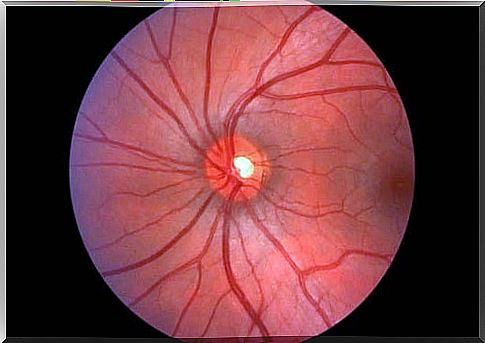What Is Papillary Edema And Why Does It Occur?

Papillary edema, also known as papilledema, is a condition that occurs in the eyes. It consists of an inflammation of the optic nerve in the area closest to the retina due to increased intracranial pressure. In this article, we will explain in detail what is papillary edema and why it occurs.
In some cases, this pathology is asymptomatic. In other situations, it affects vision. The problem is that serious health problems, such as brain tumors, can be hidden behind this disease.
What is papillary edema?
Papillary edema, as already mentioned, consists of inflammation of the optic papilla of the eye. Most often, this occurs in both eyes at the same time, in the form of bilateral edema around the optical disc.
This pathology has its origin in intracranial hypertension. The skull is a fixed bone structure, in which we find various organs and substances. One of them is cerebrospinal fluid. When something inside this box of bones increases in volume, it creates an increase in pressure.
Therefore, papillary edema occurs when the intracranial pressure rises above 200 mm of water. This growth can occur due to a mass or a tumor. Or, on the other hand, it may be the result of an increase in the amount of cerebrospinal fluid.

Possible causes
What are the symptoms of papillary edema?
The symptoms of papillary edema are variable. At first, it is often asymptomatic, and specialists discover it while performing an examination of the fundus. However, as it progresses, damage to the optic nerve fibers begins to produce obvious symptoms.
In this sense, papillary edema can affect vision. The vision may become blurred, double, or even disappear completely for a few seconds. Many patients also have sensitivity to light contrast.
Most episodes of vision loss last only a few seconds. In addition, intracranial hypertension also produces its own symptoms. For example, it often involves headaches, nausea and vomiting.
The headache is stronger on waking in the morning and tends to improve during the day. In cases where meningitis is the cause of the problem, nuchal stiffness may occur behind the neck.

What to remember about papillary edema
What we need to remember about papillary edema is that it is a pathology that affects the optic nerve. It is caused by an increase in intracranial pressure that responds to various situations. However, most cases have one thing in common: an increase in pressure inside the skull.
One of the most common causes is idiopathic intracranial hypertension. Brain tumors, bleeding and infections are also triggers. Papillary edema should be treated as a medical emergency to prevent irreparable damage to vision.









